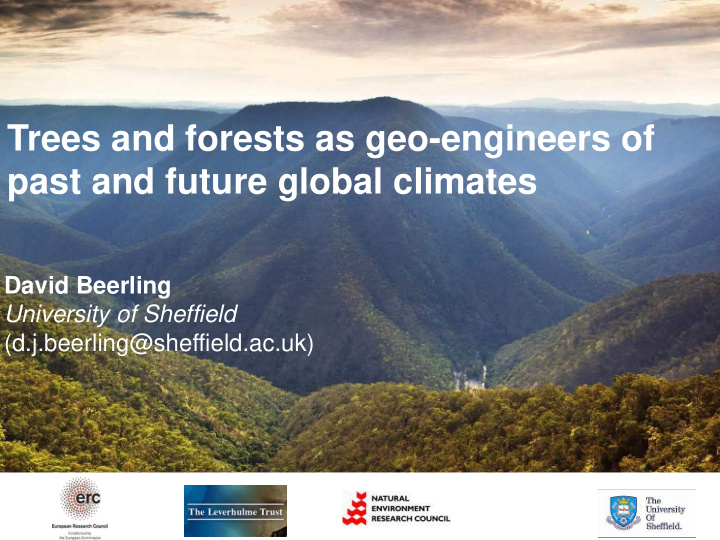



Trees and forests as geo-engineers of past and future global climates David Beerling University of Sheffield (d.j.beerling@sheffield.ac.uk)
The (bio)geochemical carbon cycle CO 2 (g) Return of CO 2 to the atmosphere CO 2 (aq) Weathering burial of CaCO 3 CO 2 + CaSiO 3 CaCO 3 + SiO 2 Metamorphism with decarbonation, e.g.: CaCO 3 +SiO 2 ->CaSiO 3 + CO 2
Fossil forests of Gilboa (385-million-years-old) Winifred Goldring (1888-1971)
One of the largest rooting systems Root type 1 ‘Trunk’ diameter = 31cm Archaeopteridalean Minimum lateral extent of rooting = ~7m progymnosperms? (Stein and Berry). ~10m max Close-up of root ‘trace’/ mould Reconstruction of Archaeopteris (Late Devonian); Beck, 1962 Images: Jenny Morris
Root type 2 Cladoxylopsids (Stein and Berry) Eospermatopteris ‘root mound’ at Cairo ~8m Reconstruction: Sandstone cast of Eospermatopteris, base of Watteiza ; Stein et al., 2007 Eospermatopteris base; Gilboa
Drilling campaigns Palaeo-Vertisols (2012, 2013) summary with slicken-sided slip planes. Total 14 cores drilled to depths of >1.5m Climate clues: Sub-tropical, with 6 cores beneath Archaeopterid stumps ( ) seasonal precipitation 7 cores beneath cladoxylopsid stumps ( ) 1 ‘control’ on surface without roots Root trace horizons map to tree size Original map by Stein, Berry et al. (in prep). Images/data: Jenny Morris
Functional differences in tree rooting depths and soil mineral interactions Cladoxylopsid Archaeopterid Drab-halo of 385 Myr-old rootlets Max. trunk base diameter (cm) Micro-XRF transect across a drab-haloed root trace 15 25 35 45 55 4500 250 0.0 4000 Max. rooting depth (m) 200 3500 Counts (dashed lines) 0.5 Counts (solid lines) 3000 150 2500 1.0 2000 100 1500 1.5 1000 50 500 2.0 Cladoxylopsid trees 0 0 0 5 10 15 20 25 30 Archaeopteridalean trees Transect mm Fe P Ca Al K 3cm Images/data: Jenny Morris
Artificially enhanced terrestrial weathering as a geoengineering Carbon Dioxide Removal strategy?
Global annual CO 2 emissions and the magnitude of the task Puny natural weathering C-sink
Enhanced weathering lowers RCP4.5 and RCP8.5 atmospheric CO 2 trajectories (Bern Carbon Cycle model) CMIP5 RCP8.5 simulations CMIP5 RCP4.5 simulations (business-as-usual) (medium-level mitigation) 100ppm 260ppm Pre-industrial value Taylor et al. (in prep)
Could we save reef-building corals? <ocean pH reduces saturation of today mineral forms of calcium carbonate, including aragonite ( a) which corals precipitation to build their skeletons. Today coral reefs exist where a>3.5 RCP8.5 (Ricke et al. (2012) Env. Res. Lett. 8 , 034003). Taylor et al. (in prep)
Beerling Research Group and (some) University of Sheffield collaborators (2014)
Recommend
More recommend